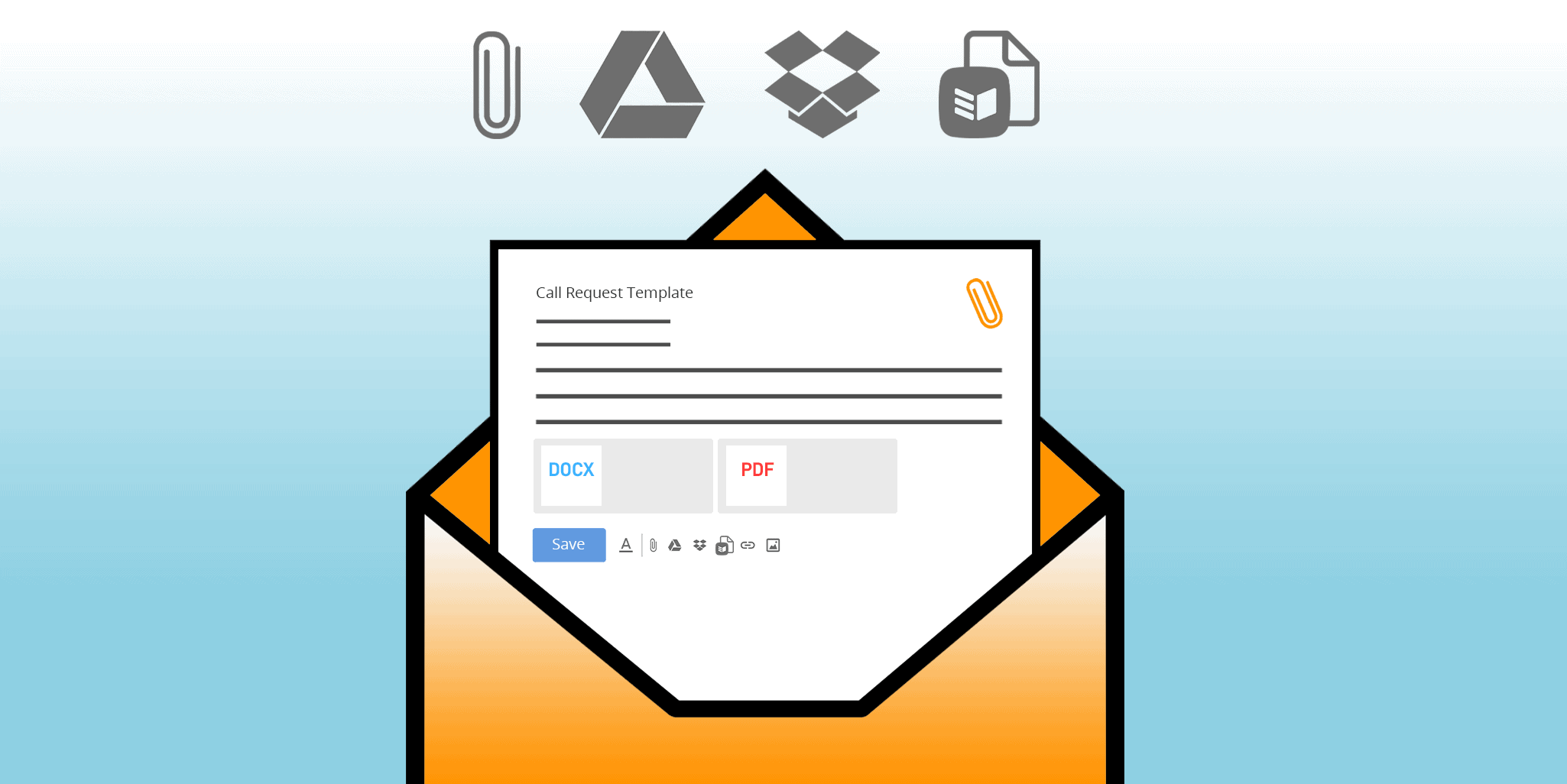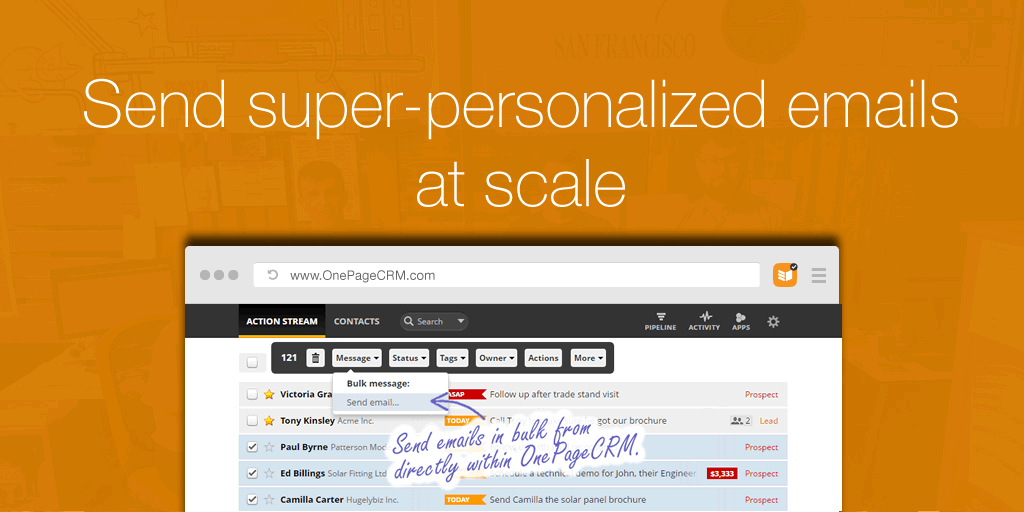

Best Shared Inbox to Manage Team Email in Gmail & Outlook

Managing emails as a team comes with a few challenges.
First of all, it’s difficult to find an affordable Shared Inbox.
But even if you find one and your team starts using a shared support@yourcompany email address, they still continue communicating with customers and prospects via their individual email addresses.
This all makes team email management very chaotic.
Communication with one client or prospect can be sitting across different inboxes, and it’s not always possible to go through all of them to restore the whole picture.
That’s why if someone goes on holiday or leaves your company, you might often struggle to pick up client conversations where they were left. Sometimes it feels like the knowledge was lost.
In this blog post, we’ll explore what a Shared Inbox inside your CRM is, how it compares to other Shared Inbox tools, and how it syncs with your Gmail and Outlook accounts.
What is a Shared Inbox?
Shared Inboxes are usually associated with support@company.com or sales@company.com—the shared email aliases that everyone has access to.
But it can be so much more than that.
This post will look into the benefits of having a Shared Inbox inside your CRM.
Why use the Shared Inbox in a CRM?
Let’s imagine that you have a team of three people:
- Sarah, a marketing specialist,
- John, a salesperson,
- Paul, customer support.
Each of them is responsible for different types of client communication and, for sure, has their individual email addresses.
Since the three of them work in different areas, in theory, they don’t need a Shared Inbox.
But things in business are not always that straightforward.
For example, if you have a loyal client who’s been your customer for the past 10 years, it’s highly likely that at some point, Sarah, John, and Paul (as well as your previous employees) have all engaged with this client.
Imagine the chaos of trying to find old email conversations with this client across several inboxes, some of which might not even be active anymore.
It’d be great if all of the client conversations were accessible to the entire team, including you. This would help new hires quickly get a grip on clients’ history and eliminate the need for back-and-forth Slack messages between team members: “Has this VIP customer contacted you already? What was the initial agreement with them, again?”
That’s where a Shared Inbox in a CRM comes into play.
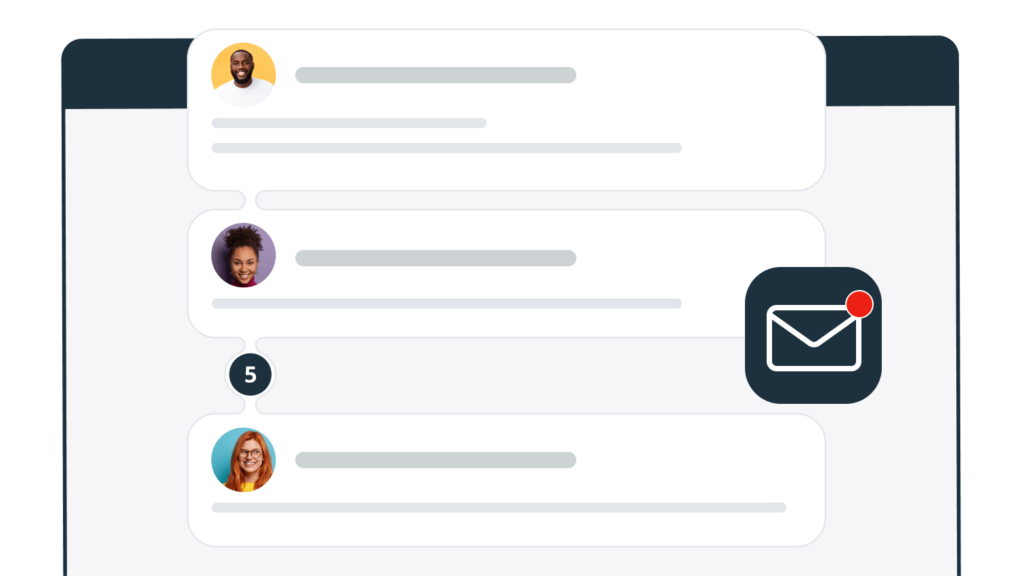
By integrating your team’s Gmail and Outlook inboxes into one Email Inbox within your CRM account, you’ll make sure that all client-related emails are logged in one place, accessible to your whole team.
If, for instance, Sarah goes on a three-week vacation, John can easily see the emails from Sarah and easily continue those conversations where sales involvement is needed.
This way, your team doesn’t lose opportunities to nurture client relationships further.
Empowering collaborative sales with Shared Inbox
Your salespeople will greatly benefit from working with marketing or support teams during the sales cycle.
The Shared Inbox inside your CRM gives them exactly that: a tool for seamless collaboration.
Try to see your whole team as a band. Each member is playing their own instrument, harmonizing perfectly to create a sweet symphony of customer satisfaction.
But what happens when the music sheets get scattered, or worse, lost?
Imagine if one of your key team members suddenly decides to move on. They’ve left the company, and with them, an inbox full of rich, unexplored conversations with customers and prospects.
Nobody quite has the time to sift through these emails, despite the goldmine of insights they could hold. It’s like an unopened treasure chest, collecting dust in the corner of the office.
This scenario is not just a frustrating nightmare; it’s a harsh reality for many businesses.
That’s where a CRM-based Shared Inbox can turn the tables.
Top 8 features of the Shared Inbox inside your CRM
Let’s delve deeper into the unique features that make the Shared Inbox in your CRM a game-changer.
Here are its top eight features:
1. Seamless two-way sync
If you juggle multiple email inboxes, you risk losing track of conversations with clients and prospects.
Picture this: it’s the end of a hectic week and you need to follow up on a promising lead. But you don’t remember whether they already talked to Sarah from support or Michael from marketing—and if they did, what they agreed on during this initial conversation.
Instead of digging through separate inboxes, a CRM email sync offers a one-in-all solution, with all emails automatically recorded and stored under each contact as well as in the separate Email tab (your Shared Inbox).
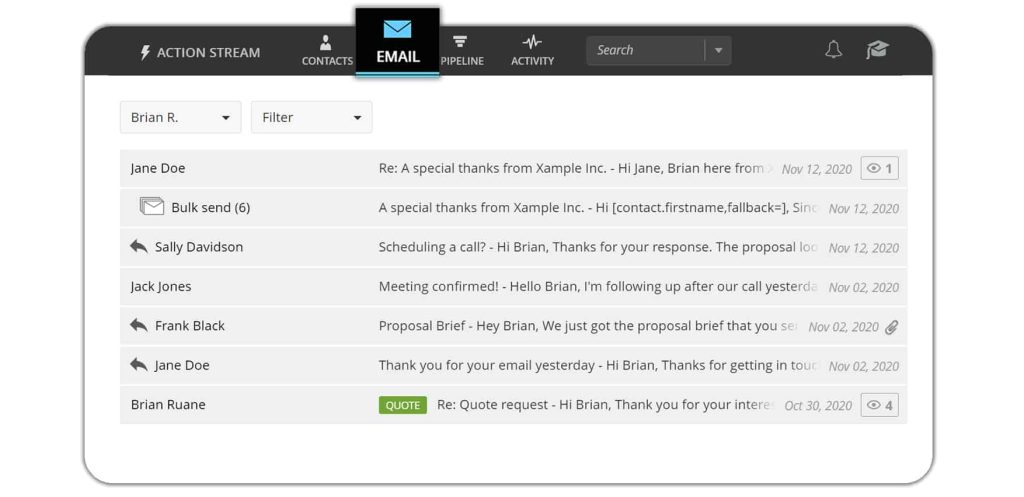
By syncing your Gmail/Outlook account with your CRM, you automatically create a comprehensive history of your client interactions. Remember the time when client preferences were mentioned offhandly in a casual email? Or the tiny detail that could make or break your proposal?
With CRM sync, these nuggets of information will never slip through the cracks.
2. Automated follow-up emails
Having a Shared Inbox inside your CRM gives you the power to effortlessly create automated workflows to speed up your sales routine.
For example, each time you add a note of the latest sales call to a contact, you can trigger an automatic thank you email to be sent to this prospect straight from your CRM.
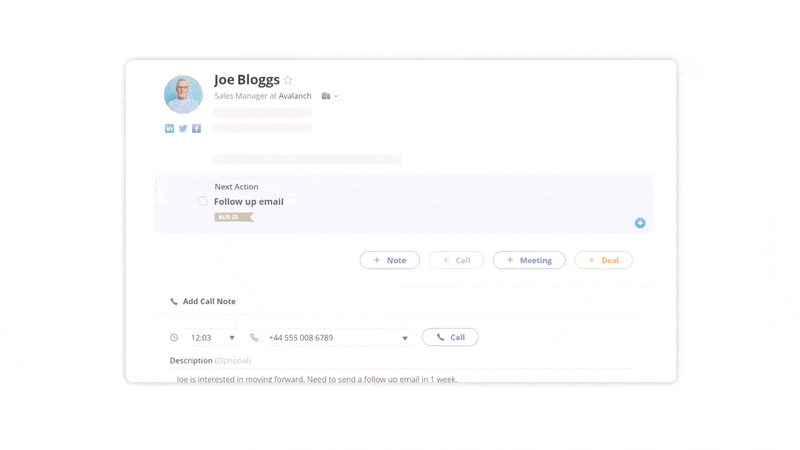
3. Leave notes for others
But the Shared Inbox is just the tip of the CRM iceberg.
A CRM system is a comprehensive tool with many features for effective sales management: from a drag-and-drop sales pipeline to deal velocity and interactive dashboards.
While emails are logged on the Contact pages, you can also add notes and tag your colleagues there to let them take over the conversation.
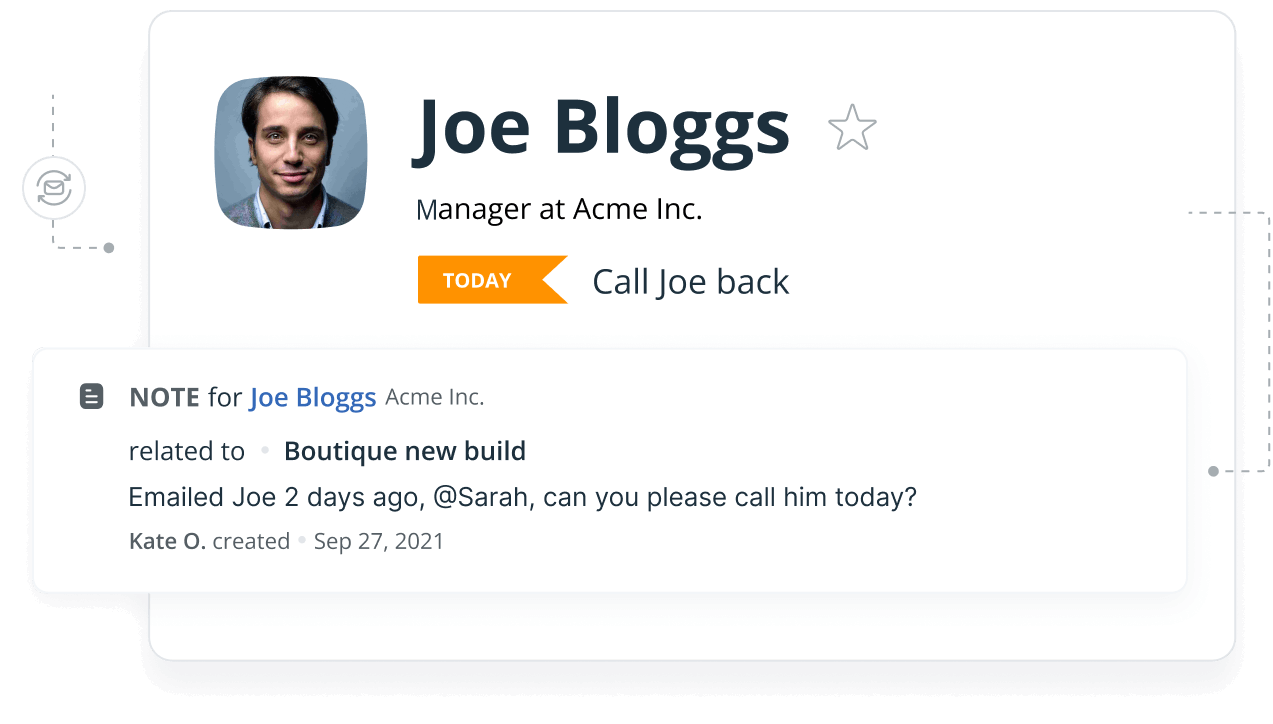
This way, not only does everything get tracked, but it also fosters a culture of collaboration within the team—making sure no piece of information, no matter how small, goes unnoticed.
It also helps to turn your sales CRM system from a management tool into a collaborative sales software.
4. Track email opens
The Shared Inbox inside your CRM is also handy if you want to know whether a prospect opened your sales proposal email—and even how many times they did this.
This is the power of having an integrated Gmail or Outlook with your CRM, it lets you peek into the unseen—the prospect’s interactions with your sales emails. Tracking read receipts in Gmail and Outlook is now easy!
You can even see if your prospects are opening your email multiple times. It could signal they’re interested and contemplating your proposal.
Knowing this, you can strategically plan your follow-up, increasing your chances of closing the deal.
5. Send bulk emails
Imagine having just attended a massive industry event and your pockets are bursting with the business cards of hundreds of potential leads. The thought of individually reaching out to each prospect seems as daunting as climbing Mount Everest.
This is where the Bulk Email Send feature in your CRM comes to the rescue.
With this feature, your CRM helps deliver your outreach message to hundreds of prospects in one go.
Since the Shared Inbox is connected to your personal email alias, each email can still feel like a personal, one-on-one message, instead of a faceless mass communication.
6. Save time with email templates
Salespeople are a bit similar to chefs trying out various recipes until they find the perfect blend of flavors.
That’s how salespeople experiment with different email templates until they discover the ones that really hit the spot.
Think of your CRM as your recipe book, a treasure trove with all your best email templates, ready for immediate use. Once you have a winning formula, it’s there for your entire team to use, multiplying the knowledge and boosting productivity.
There’s no limit to the number of email templates you can store.
You can even add attachments to these templates too. Maybe it’s your sales deck, the latest product overview, or a brochure—you decide what to include.
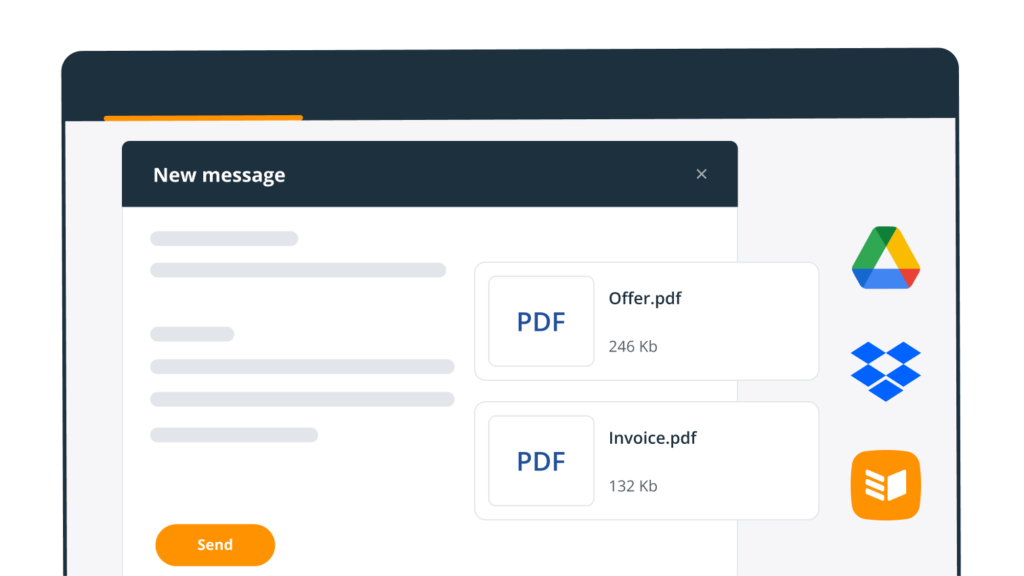
7. Collaborate on email drafts
When everyone is confined to their individual inboxes, teamwork suffers.
With a Shared Inbox, you can draft emails together. For example, one team member can start drafting a reply and then ask another team member to check the content of the email before sending it to the customer.
Sharing is caring, right? When email drafts are shared between your team, productivity increases and the quality of communication improves too.
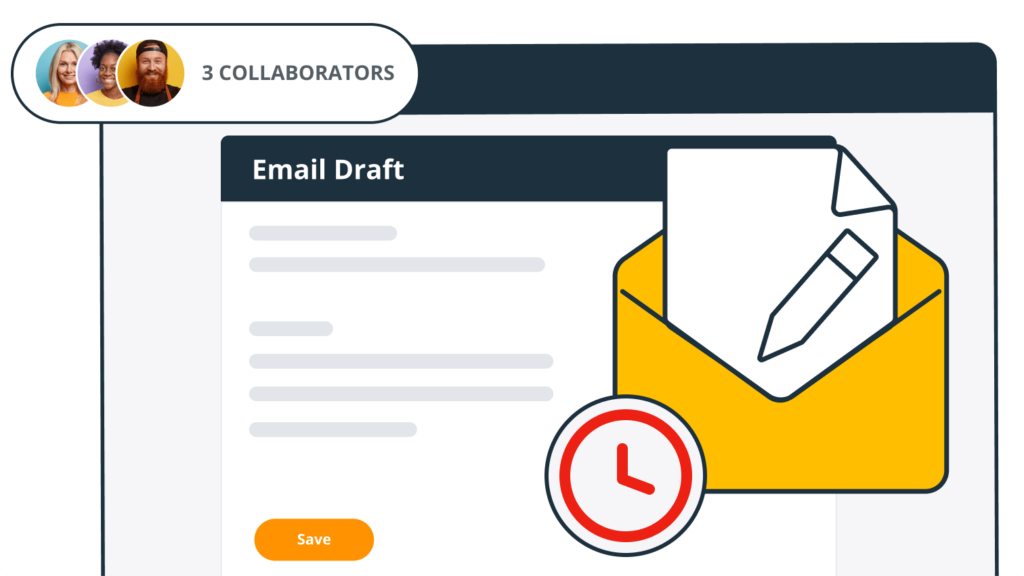
8. Schedule emails
Not all emails should be sent straight away. Sometimes it’s better to draft them in advance—and schedule for later.
If you’re just from a call with a prospect and you promised to follow up with them by the end of this week, why not schedule that follow-up email straight away?
Instead of adding a Next Action for yourself, draft a follow-up email right after the call and schedule it for a later date. This way, you can take off this task from your plate the same day.
The good news is you don’t need a separate app for this. You can schedule emails for a future date right inside OnePageCRM.
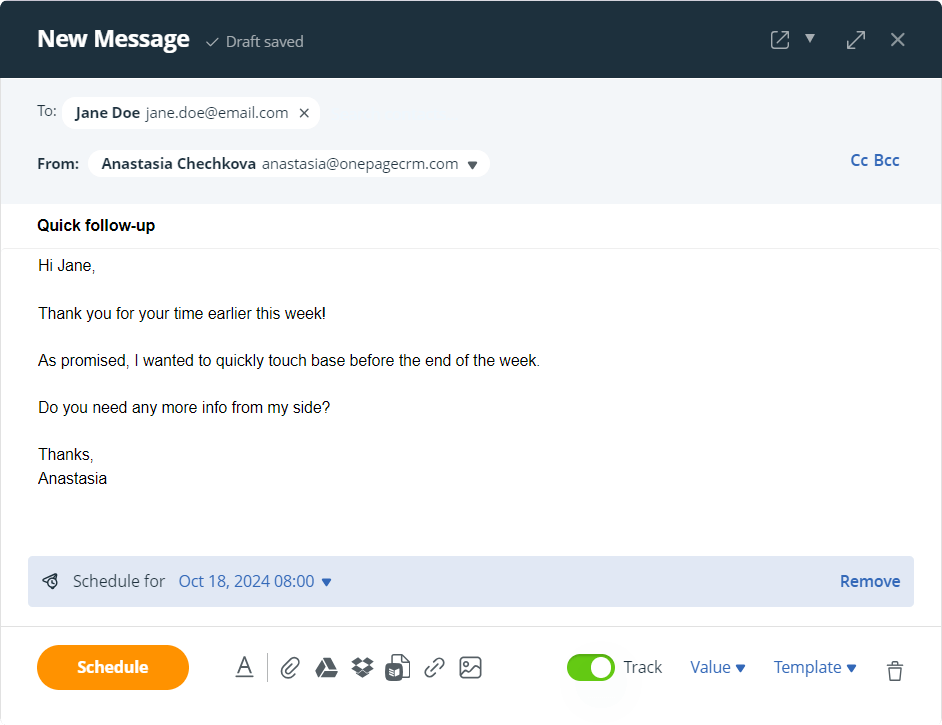
Top 3 benefits of using a CRM-based Shared Inbox
With a CRM-based Shared Inbox, you’re not just managing emails—you’re building relationships.
Imagine trying to put together a jigsaw puzzle with pieces scattered across different rooms. Annoying, right?
This is similar to trying to glue together pieces of client conversations spread across various inboxes.
A CRM shared inbox keeps all your communication puzzle pieces in one place, making it easier to see the whole picture.
1. Keep past and current client conversations in one place
If you ever played ‘Chinese Whispers’, you probably noticed how the message changes as it moves from person to person. That’s what can happen when information is passed through multiple team members via different tools.
A shared inbox within your CRM ensures everyone is on the same page. Everyone has access to the same information, reducing the chances of miscommunication.
2. Keep only contact-related emails inside your CRM
On Monday morning, your inbox is probably quite chaotic with a mix of prospect emails, newsletters, promotional offers, and perhaps a sprinkling of personal messages, all demanding your attention.
You can try to focus on your sales emails, but your eyes might catch the intriguing subject of one newsletter. Before you know it, you’re deep into an article about the newest productivity hacks.
This is why OnePageCRM syncs only contact-related emails in your CRM account.
You don’t need to worry about having your personal communication end up in the CRM.
OnePageCRM automatically detects whether there’s an associated email address in your database. If so, we’ll sync emails to the contact so you can always find them on the individual Contact’s page.
3. Avoid spam filters and firewalls
Have you ever had that experience where you’ve sent an important email and it just seems to vanish into thin air? Ended up in the dreaded Spam folder, or worse, lost in the abyss of the Social Inbox?
With a CRM-based Shared Inbox, you can send and receive emails directly using your connected email address. All sent and received emails will be associated with your email alias and will be stored in both places—your Gmail/Outlook inbox as well as the Shared Email inbox in your CRM.
That means, if you’re using “@gmail.com”, it’ll stay just like that without being changed to some random email address.
This ensures your emails get actually delivered.
Use Shared Inbox to boost client satisfaction
By having all customer interactions in one place, every team member can provide an exceptional level of service. This could make all the difference in turning leads into prospects and prospects into loyal clients.





